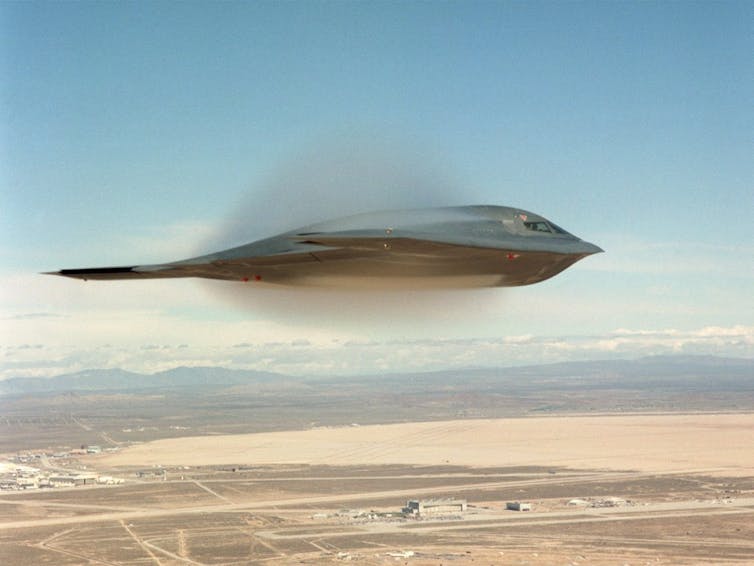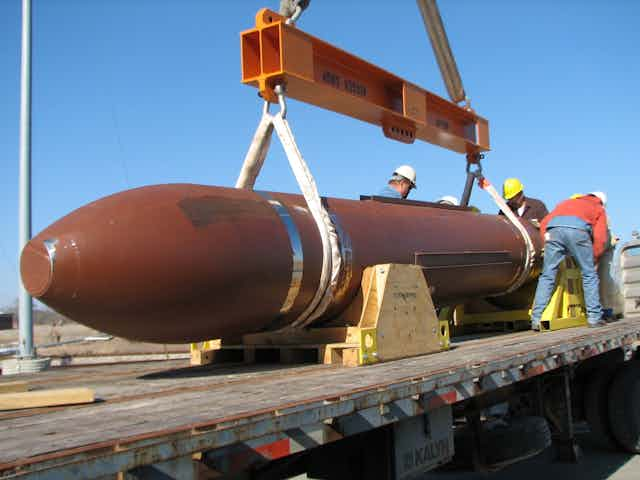The world’s largest non-nuclear bomb, and easily the most powerful “earthquake bomb” ever built, has now been tested and can be delivered by the B-2 stealth bomber.
While the Massive Ordnance Penetrator (MOP) has been under development in the US for many years, it has taken on particular geopolitical import thanks to the Iranian nuclear deadlock. At a time of heightened tension with Iran nearly two years ago, it was specifically intended to be able to destroy Iran’s deeply-buried nuclear facility at Fordow, near Qom.
Of course, this weapon didn’t come out of nowhere. Various massive conventional bombs were developed on all sides in World War II, including the 10-ton Grand Slam bomb used to destroy German U-boat pens. They came back into use during the Vietnam War, most notably in the form of the BLU-82 “Big Blue” or “Daisy Cutter”, deployed to quickly clear rainforest and make way for helipad sites (among other things).
After Vietnam, further developments led up to the notorious Massive Ordnance Air Burst (MOAB), a 9.5 ton weapon known as the “Mother of All Bombs”, and used in Afghanistan in 2002.
In parallel with this was an increasing interest in powerful weapons that could burrow deep underground. The US Air Force put considerable effort into devising weapons of a broadly similar size to the MOAB, but with the explosive charge contained inside an extremely hard metal case. The result was the GBU-57A-B Massive Ordnance Penetrator.
Two by B-2
The MOP weighs in at around 15 tons, more than six times as much as its laser-guided predecessor the GBU-28, with more than half its weight made up of the casing. It is 20 feet long, and is designed to be able to penetrate 60 feet of reinforced concrete. While it can be delivered by the old B-52 strategic bomber, the plan now is to use the B-2 – one of the most advanced war planes

The B-2 can fly 6,000 nautical miles without refuelling, has global range if refuelled, can reach an altitude of 50,000 feet, and is as near invulnerable to any defence system as can be achieved. All the B-2s in the fleet have been modified to carry two of the new bombs, of which 20 are planned to be built,
The MOP comes out of a concerted effort to develop fusing systems to defeat new bunker designs. To defy a weapon that can penetrate hugely thick reinforced concrete, one response is to use a layered bunker design, where thick layers of concrete are interspersed with voids that try to “trick” the bomb into exploding early. The GBU-57A-B has therefore undergone fusing developments so that such voids are detected and ignored.
If this weapon system was actually used in war against an opponent with modern air defences, the B-2s delivering the weapons would probably be joined by F-22 stealth strike aircraft for defence suppression, with drones following on to assess the damage in case further attacks were required. Indeed, a test of the new bomb last year involved an RQ-170 stealth drone used for this very purpose.
You can’t hide
The MOP’s most immediate diplomatic effect will obviously be on the nuclear dispute with Iran. More hawkish elements in the US see the bomb as a means to destroy Iran’s nascent nuclear capabilities if, as they expect, March’s deadline for a political deal is not met, and the relatively moderate Hasan Rouhani eventually loses power to a much more hard-line leader.
Some commentators also point out that the US now has a capability even the Israelis can’t match, making it the only power capable of taking meaningful military action against Iran’s underground bunkers.
Even so, the much broader significance of the MOP is generally being overlooked.
Thanks to this weapon, the US is now the only military power that can destroy very deeply buried and heavily protected targets anywhere in the world, and without using nuclear weapons. Its air force can now physically threaten any putative underground nuclear or command facility in a “rogue” state – or, indeed, any regime that becomes unacceptable in the future.
The MOP is, in short, yet another form of “remote control”, joining a lexicon that already boasts armed drones, Special Forces, privatised military, rendition, prompt global strike and all the elements of remote warfare steadily replacing the failed “boots on the ground” operations of recent years.
It may seem to be a small and specific development on its own but the Massive Ordnance Penetrator is actually something very much more significant.

